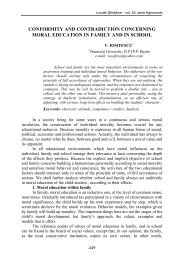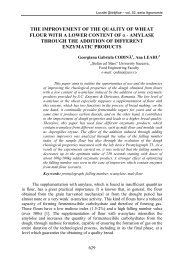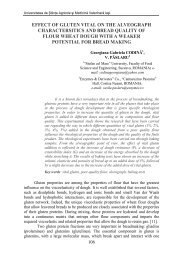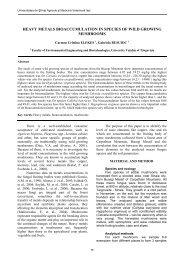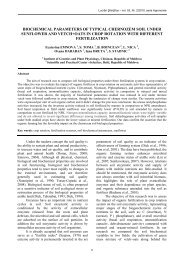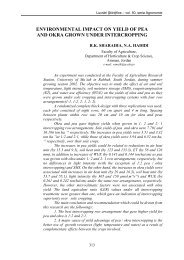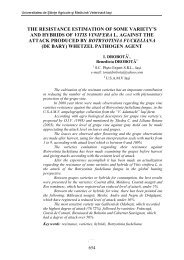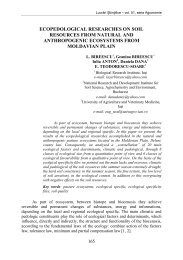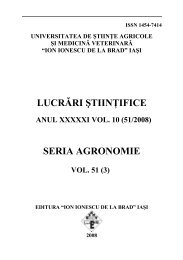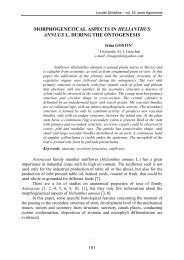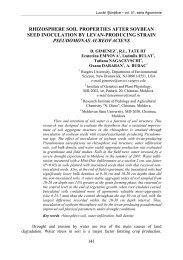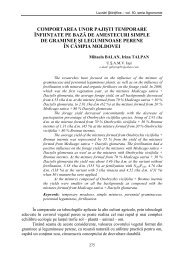introduction to ecosemiotics - LucrÄri ÅtiinÅ£ifice. Seria Agronomie
introduction to ecosemiotics - LucrÄri ÅtiinÅ£ifice. Seria Agronomie
introduction to ecosemiotics - LucrÄri ÅtiinÅ£ifice. Seria Agronomie
You also want an ePaper? Increase the reach of your titles
YUMPU automatically turns print PDFs into web optimized ePapers that Google loves.
Lucrări Ştiinţifice – vol. 51, seria <strong>Agronomie</strong><br />
of biosemiotics which has been established in the last decade of development in<br />
this field, and <strong>ecosemiotics</strong> would thus be just a synonym for biosemiotics.<br />
The obvious need for ecological semiotics can also be seen from the point<br />
made by J. Deely in his work Basics of Semiotics (1990. p.7 ): „ As au<strong>to</strong>nomous,<br />
the sphere of human culture is but relatively au<strong>to</strong>nomous, as transcending, but only<br />
by incorporating and resting upon, a physical environment shared with all forms of<br />
biological life in a larger network –biosemiosis -- of mutual dependence. The<br />
understanding of that larger whole precisely in terms of semiosis defines the<br />
complete task of which cultural semiotics forms a part”.<br />
Ecosemiotics can be defined as the semiotics of relationships between nature<br />
and culture .It deals with the semiosis going on between a human and its<br />
ecosystem, or a human in one’s ecosystem. In this, it can be related <strong>to</strong> ethnology<br />
and sociology of man-nature relationships, <strong>to</strong> environmental psychology and the<br />
anthropology of environment, which, although quite close <strong>to</strong> <strong>ecosemiotics</strong>, deal<br />
more with the comparative than the semiotic aspects of the problem.<br />
Ecosemiotics is generally considered <strong>to</strong> be a border discipline, not only<br />
because, by being a relatively new field of study, it is situated on the outskirts of<br />
the paradigm of semiotics. Ecosemiotics is a border discipline also in the intrinsic<br />
sense that it has emerged in the boundary between fields that study culture and<br />
those dealing with natural phenomena.Both of these his<strong>to</strong>rical realms of science<br />
have had difficulties in solving questions about the relations between culture and<br />
nature, and, at least <strong>to</strong> some extent, they have neglected the existence of those<br />
relations at all.<br />
For general semiotics, the emergence of biosemiotics leads <strong>to</strong> debates about<br />
the semiotic threshold and the borders of cultural semiotic systems. For cultural<br />
semiotics, the views of the founder of the Tartu school, Juri Lotman, seem <strong>to</strong> be<br />
significant. By comprehending human culture as a sphere of sign processes –the<br />
semiosphere—and by emphasizing the importance of translation processes both on<br />
the internal and external borders of that semiosphere, the focus will inevitably<br />
move <strong>to</strong> the semiotic relations between culture and other culture, nature or<br />
whatever lies behind the border.<br />
Thus, culture is not a system closed in<strong>to</strong> its semiotic <strong>to</strong>tality, but an open and<br />
dialogical entity that comunicates, influences, and is influenced by the surrounding<br />
semiotic and non-semiotic realms. It is not possible <strong>to</strong> understand culture fully<br />
without paying attention <strong>to</strong> the physical and natural environment in<strong>to</strong> which the<br />
culture is rooted by the age –old processes of meaning-making and by all temporal<br />
and spatial conceptions.<br />
For natural sciences, increasing interest <strong>to</strong>ward cultural processes also seems<br />
<strong>to</strong> be quite unavoidable. In the present day, it is quite difficult <strong>to</strong> find or construct<br />
any natural settings for biological studies, in which direct or indirect human impact<br />
does not have a significant role. Biology and other natural sciences must take<br />
human activities in<strong>to</strong> consideration now, and even more in the future, and for many<br />
problematic areas, it is necessary <strong>to</strong> understand the cultural and symbolic nature of<br />
these activities. In nature protection, where difficulties mostly originate from<br />
421




